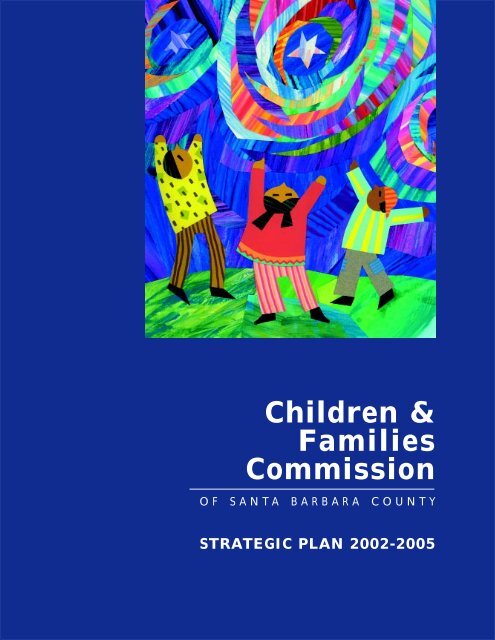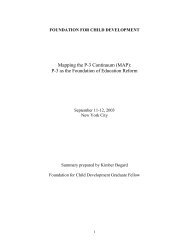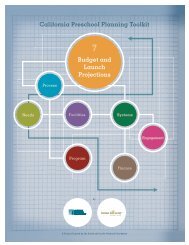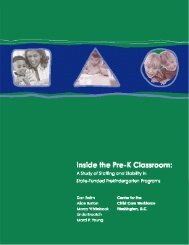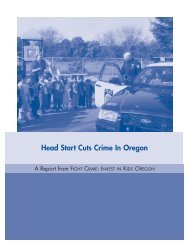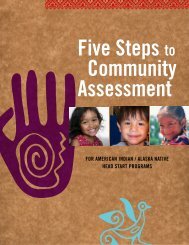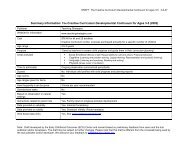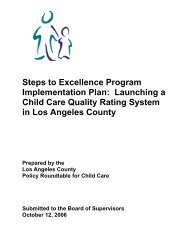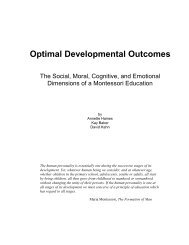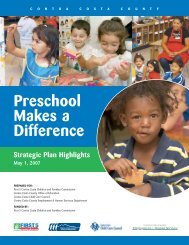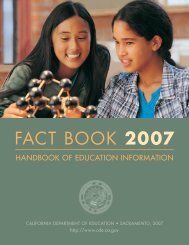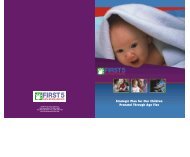Download this file - Plan4preschool.org
Download this file - Plan4preschool.org
Download this file - Plan4preschool.org
You also want an ePaper? Increase the reach of your titles
YUMPU automatically turns print PDFs into web optimized ePapers that Google loves.
Children &<br />
Families<br />
Commission<br />
OF SANTA BARBARA COUNTY<br />
STRATEGIC PLAN 2002-2005
Commissioners<br />
Naomi Schwartz (Chair)<br />
Rita Madden (Vice Chair)<br />
Mary P. Cederberg, MD<br />
Charlene Chase<br />
Bill Cirone<br />
Vincent Martinez<br />
Mary K. Ray<br />
Elliot Schulman, MD<br />
James Broderick, Ph.D.<br />
Alternates<br />
Hugo Lara (Community)<br />
Patty Moore (Community)<br />
Patti Stewart (County-Probation)<br />
Tom Urbanske (Board of Supervisors)<br />
Advisory Board<br />
John H. Paine (Chair)<br />
Susan R. Walsh, M.A (Vice Chair)<br />
Celina Andrade<br />
Nancy L. Camp<br />
Mark Campbell<br />
Maria E. Garcia<br />
Leigh Anna Groshart<br />
Debra Hosseini<br />
Robert Hubbell<br />
Mary Beth Kerr<br />
Kelly O. Lake (Commission Liaison)<br />
Cynthia Maez<br />
Jose Moctezuma<br />
Greg Nims<br />
Rosalina L. Veloz<br />
Karie Whitford<br />
Sharol Viker (Commission Liaison)<br />
Nancy Weiss<br />
Results for Children Initiative Team<br />
Hector Gonzales<br />
Hugo Lara<br />
Hedy Damery<br />
Michael P. Bates, Ph.D.<br />
Patricia Wheatley<br />
Wendy Sims-Moten<br />
Edna Phinney<br />
John H. Paine<br />
Hilda Zacarías<br />
Kelly O. Lake<br />
Naomi Schwartz<br />
Nicole Oriana Singer, Ph.D. (facilitator)<br />
Commission Staff<br />
Patricia Wheatley, Executive Director<br />
Edna Phinney, Program Analyst<br />
Wendy Sims-Moten, Financial Analyst<br />
Marita L. Bisquera, Administrative Secretary<br />
Irene Robles, Senior Office Assistant<br />
Additional Support<br />
Jerry Czuleger, Legal Advisor<br />
County Counsel<br />
Nicole Oriana Singer, Ph.D.<br />
Community Relations Coordinator<br />
Michael P. Bates, Ph.D.<br />
Evaluation Coordinator
Children &<br />
Families<br />
Commission O F S A N T A B A R B A R A C O U N T Y<br />
Santa Barbara Office<br />
1 East Anapamu Street, Suite 200<br />
Santa Barbara, CA 93101<br />
Phone: 805-884-8085<br />
Fax: 805-564-8586<br />
Santa Maria Office<br />
218 West Carmen Lane, Suite 208<br />
Santa Maria, CA 93454<br />
Phone: 805-614-1944<br />
Fax: 805-346-8366<br />
Website: www.sbccfc.<strong>org</strong>
Children &<br />
Families<br />
Commission<br />
OF SANTA BARBARA COUNTY<br />
Strategic Plan<br />
2002-2005
Special Thanks<br />
The Commission would like to thank the par<br />
ents and community-based providers who<br />
shared their dreams for children in Santa<br />
County during the development of <strong>this</strong> strategic plan.<br />
Thanks to the following <strong>org</strong>anizations that hosted<br />
community conversations: Healthy Starts in<br />
Lompoc, Santa Maria, Santa Barbara, Los Alamos<br />
and Guadalupe, Shelter Services For Women, IV<br />
Youth Projects, Catholic Charities, Starr-King and<br />
Families First. And to Hilda Zacharias for coordinating<br />
the conversations.<br />
The Commission acknowledges the work of the<br />
many <strong>org</strong>anizations who provide support to children<br />
and families and work in active partnership<br />
with the Commission to make its work possible.<br />
Special thanks to the Kids Network, Child Care<br />
Planning Council, the Center for Health Improvement<br />
and the Foundation Consortium for their<br />
support in making the 2002-2005 Strategic Plan<br />
possible.
Table of Contents<br />
Welcome 5<br />
Overview: Proposition 10 7<br />
The California Children<br />
and Families Act<br />
A Vision for Santa Barbara 9<br />
County’s Youngest Children<br />
The Strategic Planning Process 13<br />
Results: Hopes and Dreams for 17<br />
Santa Barbara County’s<br />
Young Children<br />
Indicators: Measuring Our Success 19<br />
Strategies and Funding Priorities 21<br />
Fiscal Strategies and Allocations 27<br />
Accountability and Evaluation 31<br />
A Call to Action 33<br />
Appendices 35<br />
Commission Highlights 37<br />
Local Data 43<br />
Resources 47
Welcome<br />
A child’s brain develops most dramatically during the first three years of<br />
life, and what parents and caregivers do during those early years makes<br />
a profound difference for the rest of their children’s lives.<br />
—Rob Reiner, Chair<br />
California Children and Families Commission<br />
Santa Barbara County is home to<br />
26,008 children ages 0-5 years old.<br />
Each year approximately 6,000 new babies<br />
are born in the County. They represent the<br />
growing diversity of California. More than 50%<br />
are of Hispanic/Latino descent, nearly 40% are<br />
White and the remaining 8% are Asian-Pacific<br />
Islander, African American and American Indian/Alaska<br />
Native. They are growing up in<br />
urban communities, small towns and the rural<br />
areas throughout the County. They come from<br />
different cultures and backgrounds. Some live<br />
in houses or apartments, others live in shelters<br />
or on the streets. But, for every one of these<br />
children, their earliest experiences will lay the<br />
emotional, physical and intellectual foundation<br />
that influences the rest of their lives.<br />
Giving every child the best possible start in<br />
life is the overriding goal of Proposition 10 and<br />
the work of Children and Families Commission’s<br />
across California. The Children and Families<br />
Commission of Santa Barbara County’s 2002-<br />
2005 Strategic Plan is an invitation to all individuals<br />
who are concerned about the well-being<br />
of children to join in making a difference at<br />
the most critical period of their development.<br />
The 2002-2005 Strategic Plan presents the<br />
Children and Families Commission’s vision for<br />
all children. Included is our role in making <strong>this</strong><br />
vision a reality, the key results we are working<br />
towards, strategies we think will work and how<br />
we will measure our success. It represents the<br />
voices of hundreds of parents and dedicated<br />
providers of services for families—each committed<br />
to supporting the children in their lives and<br />
their communities.<br />
We invite you to join us in building a community<br />
of support for our youngest children.<br />
It’s all about the children!<br />
Chair, Children and Families Commission<br />
of Santa Barbara County
Overview:<br />
Proposition 10—The California<br />
Children & Families Act<br />
About Proposition 10—<br />
The California Children<br />
and Families Act<br />
In November 1998, California voters passed<br />
Proposition 10—the California Children and<br />
Families Act, to help make sure that our youngest<br />
children get the best possible start in life.<br />
The Proposition increased the tax on tobacco<br />
products by 50 cents to fund early childhood<br />
development, heath care and parent education<br />
and support programs targeting children from<br />
prenatal to age five and their families. Specifically,<br />
the purpose of the Act is to:<br />
• promote, support and improve the early<br />
development of children, prenatal to age<br />
five;<br />
• establish and coordinate comprehensive,<br />
integrated programs emphasizing community<br />
awareness, education, nurturing, child<br />
care, social services, health care and<br />
research; and<br />
• provide for greater local flexibility in<br />
designing effective service delivery systems<br />
and eliminating duplication<br />
Focus of the Act<br />
The Children and Families Act focuses on four<br />
areas critical to the healthy development of<br />
children:<br />
• Improved Child Health: Healthy Children<br />
• Improved Child Development: Children<br />
Learning and Ready for School<br />
• Improved Family Functioning: Strong<br />
Families<br />
• Improved Systems for Families: Integrated,<br />
Accessible, Inclusive, and Culturally<br />
Appropriate Services<br />
State and Local Governance<br />
A state commission and local commissions in<br />
each of California’s 58 counties were created to<br />
administer the approximately $700 million<br />
generated annually through the tobacco tax.<br />
State Commission: The California Children<br />
and Families Commission is responsible for the<br />
state-level administration of the Act, which includes<br />
developing program guidelines, reviewing<br />
county strategic plans and conducting an<br />
Strategic Plan 2002–2005 7
annual program review and evaluation. In addition,<br />
20 percent of the overall revenue is administered<br />
by the State Commission to fund<br />
mass media communications, parent and provider<br />
education, child care, research and administration.<br />
County Commissions: Eighty percent of the<br />
revenues collected annually are allocated to local<br />
communities by commissions in each county<br />
based on the live birth rate. Each 5 to 9 member<br />
commission is responsible for developing a<br />
strategic plan to guide local funding decisions<br />
that are consistent with the intent of the Children<br />
and Families Act.<br />
Proposition 10 in<br />
Santa Barbara County<br />
The Children and Families Commission of<br />
Santa Barbara County was established in February<br />
1999 to plan and oversee the estimated<br />
$5.5 million in Proposition 10 funds that come<br />
into the county each year. The 13-member<br />
Commission (9 commissioners and 4 alternates)<br />
works closely with an Advisory Board, families,<br />
local community based <strong>org</strong>anizations, public<br />
agencies and the community-at-large to set local<br />
priorities that support the optimal development<br />
of Santa Barbara County’s young children.<br />
The Commission serves as a grant-maker<br />
responsible for allocating Proposition 10 resources<br />
in Santa Barbara County. It has also established<br />
its role as:<br />
• A community partner working with<br />
existing public and private <strong>org</strong>anizations<br />
for the benefit of children<br />
• A catalyst to promote community support<br />
for young children and families<br />
• A convener and facilitator to bring<br />
together individuals and agencies with<br />
common goals<br />
The Commission is locally focused on the<br />
children and families of Santa Barbara County<br />
and an active partner with the State and other<br />
County Commissions on issues and areas of<br />
common concern.<br />
Proposition 10 in Action<br />
The Children and Families Commission of<br />
Santa Barbara County was among the first Commissions<br />
to adopt a strategic plan—a legislative<br />
requirement for receiving Proposition 10 funds.<br />
This allowed the Commission to move quickly<br />
in allocating resources to community programs<br />
that support young children and their families.<br />
Since the passage of the 2000-2003 Strategic<br />
Plan, the Commission has hired staff, released<br />
over $10 million in funds over two<br />
funding cycles, and worked extensively with local<br />
and statewide <strong>org</strong>anizations to move Proposition<br />
10 from a vision to a reality. What has<br />
been accomplished extends far beyond the dollars<br />
allocated. The Commission’s commitment<br />
to building on existing services, working with<br />
families and local community based <strong>org</strong>anizations<br />
and leveraging resources has had a direct<br />
impact on the lives of children and families.<br />
(For more information about the Commission’s<br />
major accomplishments please refer to the section<br />
included in the appendices)<br />
8 Children & Families Commission of Santa Barbara County
A Vision for Santa<br />
Barbara County’s<br />
Youngest Children<br />
We hope that when our children grow up they will be confident, successful and<br />
healthy; that they are accepted and supported by their community; that they<br />
have strong morals and serve their communities.<br />
—Santa Barbara County parent<br />
Today we know more than ever<br />
about the influence of a child’s ear<br />
liest experiences on his or her long-term<br />
development, physical health and educational<br />
success. We know that in the first years of a<br />
child’s life, critical connections are made in the<br />
brain that impact lifelong learning. These new<br />
findings present our communities with an opportunity<br />
and a responsibility to work together<br />
to nurture and support our youngest<br />
children.<br />
The work of the Children and Families<br />
Commission is guided by The Vision that…<br />
All children in every community of Santa<br />
Barbara County will thrive in safe, supportive,<br />
nurturing, and loving environments;<br />
enter school as healthy, active learners;<br />
develop resilience; and become productive,<br />
well-adjusted members of society.<br />
The Commission is committed to making a<br />
difference by fulfilling the following Mission…<br />
The Children and Families Commission of<br />
Santa Barbara County is committed to<br />
working with families and communities to<br />
improve the lives of young children and<br />
their families through a countywide comprehensive,<br />
integrated and sustainable system<br />
of support and services that promotes<br />
optimal childhood development.<br />
Guiding Principles<br />
The Children and Families Commission’s work<br />
and decision making are guided by mutually<br />
agreed upon principles. They are committed to:<br />
1. Developing a county-wide environment<br />
where children are safe<br />
Strategic Plan 2002–2005 9
12. Supporting prevention efforts to reduce<br />
the use of tobacco and the effects of<br />
secondhand smoke on infants and young<br />
children<br />
13. Defining desired results for children and<br />
families and documenting the progress<br />
towards achieving them to ensure<br />
accountability and effectiveness<br />
14. Engaging in an ongoing dynamic and<br />
evolving strategic planning process to<br />
meet the changing needs of our<br />
communities<br />
2. Providing support to parents and all<br />
other caregivers to help children achieve<br />
their greatest potential<br />
3. Honoring and supporting families as<br />
their children’s first teachers and<br />
strongest advocates<br />
4. Respecting the social, cultural and ethnic<br />
diversity of families and communities<br />
5. Strengthening opportunities for children<br />
and families by facilitating community<br />
involvement in identifying needs and<br />
innovative solutions<br />
6. Encouraging and supporting the<br />
development of each community’s<br />
capacity to provide and sustain<br />
integrated services<br />
7. Supporting and encouraging outreach to<br />
geographically and socially isolated<br />
families<br />
8. Supporting access to services for all<br />
families in an environment of support<br />
and respect<br />
9. Maximizing the percentage of dollars<br />
going to direct services and funding<br />
community programs in a timely manner<br />
10. Developing and maintaining a system of<br />
countywide equitable funding consistent<br />
with the Commission’s strategic goals<br />
11. Utilizing Commission funds to leverage<br />
additional local, state and federal<br />
resources to support program<br />
enhancement and sustainability<br />
A Commitment to Equity<br />
and Diversity<br />
The Commission, in fulfilling its mission, will<br />
“take proactive steps to ensure that (Santa Barbara<br />
County) children and their families from<br />
diverse populations, including children with<br />
disabilities, (homeless children and children<br />
with) other special needs are an integral part<br />
of the planning and implementation of Proposition<br />
10.” 1 The Principles on Equity developed<br />
by the State Committee on Equity will<br />
serve as a guide throughout the work of the<br />
Commission:<br />
1. Inclusive Governance and Participation:<br />
to obtain meaningful participation and<br />
input of the families and other caregivers<br />
of children from diverse backgrounds with<br />
diverse abilities.<br />
2. Access to Services: to assure that children<br />
from diverse backgrounds and with diverse<br />
abilities have access to high quality early<br />
care and education/development opportunities.<br />
3. Legislative and Regulatory Mandates:<br />
to ensure that funded programs adhere to<br />
all legislative, regulatory and accreditation<br />
mandates pertinent to the provision of<br />
services to children from diverse backgrounds<br />
and with diverse abilities<br />
1<br />
Adapted from the Advisory Committee on Diversity,<br />
California Children and Families Commission<br />
10 Children & Families Commission of Santa Barbara County
4. Results-Based Accountability: to ensure<br />
that Proposition 10 programs have<br />
meaningful outcomes that benefit children<br />
from diverse backgrounds and with diverse<br />
abilities.<br />
School Readiness<br />
The intent of the Children and Families Act<br />
was to focus attention and support for children<br />
in the vital years prior to kindergarten. The<br />
Commission recognizes that <strong>this</strong> will be critical<br />
in making sure that all children have the best<br />
possible chance of achieving their full potential<br />
when they enter school. The Commission is<br />
currently developing local school readiness<br />
projects as a result of the release of the State<br />
Commission’s School Readiness Initiative. This<br />
will bring additional dollars for programs focused<br />
on preparing children ages 0-5 to enter<br />
kindergarten. In developing its School Readiness<br />
Initiative, the State Commission adopted<br />
the National Education Goals Panel definition<br />
of school readiness. School readiness includes:<br />
1) Children’s readiness for school<br />
• physical well-being and motor development<br />
• social and emotional development<br />
• approaches to learning<br />
• language development<br />
• cognition and general knowledge<br />
2) Schools’ readiness for children<br />
• approaches that have been shown to<br />
raise achievement for each student<br />
• a willingness to alter practices and<br />
programs if they do not benefit children<br />
• assuring that their students have access<br />
to services and supports in the community<br />
3) Family and community supports and<br />
services that contribute to children’s<br />
readiness for school success<br />
• access to high-quality and developmentally<br />
appropriate early care and education<br />
experiences<br />
• access by parents to training and support<br />
that allows parents to be their child’s<br />
first teacher and promotes healthy<br />
functioning families<br />
• (support and encouragement for families<br />
active involvement and participation as<br />
partners in school readiness programs)<br />
• prenatal care, nutrition, physical activity<br />
and health care that children need to<br />
arrive at school with healthy minds and<br />
bodies and to maintain mental alertness<br />
Santa Barbara County will utilize these principles<br />
in structuring local school readiness programs<br />
that build on the strength of existing child<br />
development and family support services already<br />
being funded by the Commission. The Commission<br />
will continue to encourage and support<br />
partnerships between families, schools, early<br />
care and education and the community-at-large<br />
through the School Readiness Project and<br />
throughout its work in Santa Barbara County.<br />
• a smooth transition between home and<br />
school<br />
• continuity between early care and<br />
education programs and elementary<br />
grades<br />
• a student-centered environment focused<br />
on helping children learn<br />
• a commitment to the success of every<br />
child<br />
Strategic Plan 2002–2005 11
12 Children & Families Commission of Santa Barbara County
The Strategic<br />
Planning Process<br />
The reason we are working as many jobs as we are is to<br />
create a better future for our children.<br />
—Santa Barbara County parent<br />
In Santa Barbara County, the Children<br />
and Families Commission is charged<br />
with developing, adopting and implementing<br />
a strategic plan for spending Proposition 10<br />
funds—an estimated $5.5 million annually—on<br />
programs that serve young children and their<br />
families. The Commission made a commitment<br />
from the onset to planning that is inclusive of<br />
the individuals and communities that have the<br />
greatest stake in impacting the lives of children.<br />
They have also made a commitment to a results-based<br />
approach that focuses on the results<br />
they wish to achieve for children.<br />
Through the strategic planning framework,<br />
the Commission works with families, providers<br />
and local and statewide experts to design a results-based<br />
plan. The planning process includes:<br />
• Defining the vision, mission, and guiding<br />
principles for the Commission’s work<br />
• Assessing the needs of children and<br />
families in Santa Barbara County and the<br />
priorities of the community<br />
• Establishing criteria for setting priorities at<br />
each stage of the planning process<br />
• Choosing desired outcomes and priority<br />
strategies to guide Commission activities<br />
• Defining processes for selecting programs<br />
and services to achieve the desired outcomes<br />
• Setting guidelines for allocating funds and<br />
building long-term sustainability<br />
• Building evaluation processes to ensure<br />
accountability<br />
The 2000-2003 Strategic Plan<br />
To develop the first Strategic Plan (Fiscal Year<br />
2000-2003), the Commission hosted a series of<br />
community forums throughout the county to<br />
gather input from families, caregivers and service<br />
providers on the strengths and weaknesses<br />
of existing services, and desired services currently<br />
unavailable. In a series of town meetings,<br />
470 families were surveyed (266 in English and<br />
204 in Spanish).<br />
Eighty-three service providers submitted<br />
questionnaires with feedback on local services.<br />
Strategic Plan 2002–2005 13
Data related to the status and needs of children<br />
prenatal to age five and their families were<br />
gathered from partner <strong>org</strong>anizations. Specific<br />
categories of information included: demographics,<br />
economic security, wellness/health, education,<br />
child care and children and families with<br />
challenges. The Commission utilized the<br />
community input and additional statistical information<br />
to determine local needs, community<br />
assets and to set priorities for the focus of their<br />
work in the first three years.<br />
The Children and Families Commission of<br />
Santa Barbara County has completed two grant<br />
making cycles, established the infrastructure<br />
of the Commission, participated as one of four<br />
counties in the Results for Children Initiative<br />
and been actively involved locally and statewide<br />
in supporting the improvement of the system<br />
of support for young children and their<br />
families. The intent of updating the initial strategic<br />
plan is to:<br />
• reflect on the accomplishments since the<br />
Commission was formed in 1999;<br />
• update the plan with new data and<br />
information;<br />
• refine the focus on the results that families,<br />
providers and the Commission want to see<br />
for children and families in Santa Barbara<br />
County;<br />
• prioritize the strategies that will lead to the<br />
desired results for children;<br />
• incorporate the Commission’s progress<br />
and commitment to fiscal and programmatic<br />
sustainability<br />
• adjust for projected decrease in revenue<br />
The 2002-2005<br />
Updated Strategic Plan<br />
The 2002-2005 Strategic Plan builds on the<br />
foundation of the initial plan. The first strategic<br />
plan was developed when the State and local<br />
Children and Families Commissions were in<br />
their infancy. Since the first plan was approved<br />
in January 2000, the State Commission has<br />
launched statewide initiatives and educational<br />
campaigns, established an Advisory Committee<br />
on Diversity and developed its own strategic plan.<br />
Community Input<br />
and Engagement<br />
The Plan for 2002-2005 is the result of extensive<br />
dialogue among Commissioners, the Advisory<br />
Board, families, community members,<br />
service providers and content experts. It reflects<br />
the Commission’s commitment to working with<br />
its community partners to ensure that the Strategic<br />
Plan is focused on jointly developed results<br />
and priorities.<br />
The Results for Children<br />
Initiative<br />
One of the major influences on the development<br />
of the 2002-2005 Strategic Plan was the<br />
Commission’s participation in the Results for<br />
Children Initiative (RCI). The Initiative, funded<br />
by the Foundation Consortium, a group of<br />
California foundations, is providing four<br />
14 Children & Families Commission of Santa Barbara County
Proposition 10 Commissions with technical<br />
assistance aimed at increasing community involvement<br />
and decision making to meet the<br />
goals of Proposition 10. Each County Commission<br />
participating in RCI has worked to<br />
expand the involvement of families, providers<br />
and the community-at-large in being a voice for<br />
the children and families in their communities.<br />
Community Conversations<br />
Families who raise children and individuals who<br />
spend their professional lives supporting young<br />
children and families are the true experts on<br />
what children need. During the months of August<br />
and September 2001, the Commission<br />
worked with partner <strong>org</strong>anizations to hold a series<br />
of focused community conversations with<br />
families and service providers. The goals of the<br />
Community Conversations were to:<br />
• Bring the voices of families into the<br />
strategic planning process<br />
• Build a culture of inclusive governance<br />
• Identify the results that matter to families<br />
For the 2002-2005 strategic planning process,<br />
smaller, focus groups were held in communities<br />
across Santa Barbara County. The Community<br />
Conversations were scheduled around<br />
convenient times for families—evenings, lunch<br />
hours and weekends were optimal. Child care,<br />
transportation and food were provided. Conversations<br />
were held in English and Spanish.<br />
Groups of 15 to 30 participants met to discuss<br />
what they see as the priorities for their children.<br />
Parents were asked to respond to the following<br />
questions:<br />
• What do you hope and dream for your<br />
children when they grow up?<br />
• What do you want most for the children in<br />
your community?<br />
• Who would make their dreams come true<br />
in your community?<br />
• What do you want to see when your<br />
children enter school?<br />
• What works for you as a parent?<br />
• How can you be a partner in <strong>this</strong> work?<br />
• How can we invest these dollars that<br />
belong to all of us?<br />
Families brought a diversity of backgrounds<br />
and experiences and yet shared common dreams<br />
for their children:<br />
• Educational and professional success<br />
• Confidence and self-sufficiency<br />
• Strong values and moral character<br />
• Serving their communities<br />
• Healthy<br />
• Living in safe communities<br />
They see themselves as responsible for making<br />
these dreams come true for their children<br />
in partnership with the Commission, schools,<br />
community <strong>org</strong>anizations, elected officials, businesses<br />
and the community-at-large.<br />
Parents saw the need to invest Proposition<br />
10 resources in the services and support that<br />
enables them to provide support their children:<br />
• Access to Health Services<br />
• Parent Education<br />
• Resource Centers for Families<br />
• School-Home Communication (in their<br />
primary language)<br />
• Child Care Center Capacity<br />
• Advocacy and Education<br />
• Transportation Services<br />
Strategic Plan 2002–2005 15
In October 2001, a Community Conversation<br />
was also held with approximately 80 community<br />
service providers. Providers were asked<br />
to respond to the same questions as the families<br />
and additional questions about more effectively<br />
reaching families and prioritizing funding in the<br />
event of declining revenue.<br />
The voices of the families and community<br />
service providers who participated in the Community<br />
Conversations guided the 2002-2005<br />
strategic planning process. The outcomes and<br />
strategies that are presented in the plan are a<br />
direct result of what was heard from families of<br />
young children in communities across Santa<br />
Barbara County.<br />
conversations; 3) the Results Based Accountability<br />
framework and; 4) fiscal projections. The<br />
information was then used to formulate the desired<br />
outcomes and priorities into what would<br />
become the 2002-2005 Strategic Plan.<br />
The Commission sees its strategic planning<br />
as ongoing and open to review and changes as<br />
new needs and priorities emerge. The State requirement<br />
of annually reviewing and updating<br />
the strategic plan is an opportunity to build<br />
relationships and communication between the<br />
Commission and the community.<br />
Developing the Strategic Plan<br />
In October and November 2001, the Commission,<br />
Advisory Board, Results for Children<br />
Leadership Team and community participants<br />
participated in two strategic planning sessions.<br />
The purpose of the sessions was to integrate:<br />
1) new local data; 2) results from the community<br />
16 Children & Families Commission of Santa Barbara County
Results: Hopes and<br />
Dreams for Santa<br />
Barbara County’s<br />
Young Children<br />
Creating a community that strives<br />
to give all children the best possible<br />
start in life requires the commitment<br />
and involvement of each parent, each service<br />
provider and anyone who cares for and about<br />
children. The Children and Families Commission<br />
believes that only by working with its community<br />
partners and hearing the voices of the<br />
community can it really make a difference for<br />
children.<br />
The Commission has committed to utilizing<br />
Inclusive Governance to ensure that people with<br />
the greatest stake in what happens to children<br />
have an active role in the design and evaluation<br />
of the programs affecting them. They have<br />
adopted a Results Based Accountability approach<br />
that focuses on results—defining what<br />
we want to see for children and families, choosing<br />
strategies that we think will work and measuring<br />
the progress we are making towards these<br />
desired results.<br />
Priority Results have been selected to guide<br />
local decision making and serve as a reminder<br />
that the dream for all children in Santa Barbara<br />
County is that they:<br />
• are born and remain physically and<br />
mentally healthy;<br />
• are learning and prepared to succeed in<br />
kindergarten;<br />
• live in safe, supportive and nurturing<br />
environments;<br />
• and live in communities where services and<br />
supports for families are comprehensive,<br />
integrated, non-duplicative, accessible and<br />
culturally responsive.<br />
Within the Four Result Areas defined by the<br />
Children and Families Act, the Commission’s<br />
planning process led to the selection of Desired<br />
Outcomes that will guide the Commission’s<br />
work over the next three years.<br />
Strategic Plan 2002–2005 17
Improved Child Health: Healthy Children<br />
Children are born and remain physically and mentally healthy<br />
Desired Outcomes<br />
1. Families have access to and utilize comprehensive, preventative and primary health care.<br />
2. Children are born healthy and ready to develop to their full potential.<br />
3. Families are aware of the importance of child health and development.<br />
Improved Child Development:<br />
Children Learning and Ready for School<br />
Children are learning and prepared to succeed in school<br />
Desired Outcomes<br />
1. Families have access to and are receiving high quality early care and education.<br />
2. Children enter kindergarten emotionally, physically and developmentally prepared to<br />
succeed.<br />
Improved Family Functioning: Strong Families<br />
Children live in safe, supportive, and nurturing environments<br />
Desired Outcomes<br />
1. Parents, including those with children with special needs, have access to services and<br />
resources to support optimal child development and healthy parenting.<br />
2. Children live in stable and nurturing family environments free from family violence and<br />
exposure to tobacco, alcohol and drug abuse.<br />
Improved Systems for Families:<br />
Integrated, Accessible, Inclusive, and Culturally<br />
Appropriate Services<br />
Services are comprehensive, integrated, non-duplicative, and culturally responsive<br />
Desired Outcomes<br />
1. Services are consumer-oriented, accessible, locally available and geographically equitable.<br />
2. Communities have adequate service capacity, which is effective, coordinated, integrated,<br />
non-duplicative and sustainable to address the needs of families.<br />
18 Children & Families Commission of Santa Barbara County
Indicators:<br />
Measuring Our Success<br />
The Children and Families Commission<br />
is committed to measuring the<br />
progress towards achieving the desired<br />
results for children. Prior to the formation of<br />
the Children and Families Commission, the<br />
KIDS Network and the UCSB Gevirtz Graduate<br />
School of Education had established an annual<br />
Children’s Scorecard. The Commission has<br />
joined as a partner in the development of the<br />
Scorecard, to bring special focus on the status<br />
of children prenatal to age five. Within the<br />
Scorecard, four new indicators have been added:<br />
1. Access to Prenatal Care: Percent of expecting<br />
mothers receiving prenatal care beginning<br />
in the first trimester of pregnancy. Early<br />
access to high-quality prenatal care services<br />
is an important predictor of children’s<br />
health and development during infancy<br />
and early childhood.<br />
2. Infant Mortality Rate: Yearly rate of deaths<br />
for children less than 1-year-old. Infant<br />
mortality is generally considered a key<br />
public health indicator that reflects the<br />
general health status of a community, as<br />
well as equity and quality of health<br />
services.<br />
3. Child Care Supply: Total number of spaces<br />
in licensed early care and education centers<br />
and family homes. Access to high quality,<br />
developmentally appropriate early care and<br />
education, provides early socialization and<br />
learning experiences that help children<br />
prepare for success in elementary school.<br />
4. Reading Achievement: Percent scoring above<br />
the 50 th percentile on reading, language,<br />
and math assessments. Broad measurement<br />
of reading ability in early elementary<br />
school is an indicator of how well children<br />
0-5 are being prepared to succeed in<br />
school.<br />
Additionally, five existing indicators have<br />
been reanalyzed to provide information specific<br />
to the 0-5 age group:<br />
1. Child Population<br />
2. Families and children living in poverty<br />
3. Children in families in the CalWORKS<br />
progam<br />
4. Children receiving special education<br />
5. Homelessness<br />
(Taken from the Santa Barbara County Children’s Scorecard 2001.<br />
See the Scorecard for current data)<br />
Strategic Plan 2002–2005 19
The Commission has a long-term commitment<br />
to data development. Locally and<br />
statewide, Children and Families Commissions<br />
are setting in place systems to document program<br />
results and community-wide changes in<br />
outcomes for children. The Commission is<br />
working in partnership with the KIDS Network,<br />
the Gevirtz Graduate School of Education and<br />
county and community partners to continuously<br />
improve the community’s capacity to document<br />
the progress in improving the lives of Santa Barbara<br />
County’s children.<br />
20 Children & Families Commission of Santa Barbara County
Strategies and<br />
Funding Priorities<br />
All Children in every community of Santa Barbara<br />
County will thrive in safe, supportive, nurturing,<br />
and loving environments; enter school as healthy,<br />
active learners; develop resilience; and become<br />
productive, well-adjusted members of society.<br />
—Children & Families Commission Vision<br />
Proposition 10 has given communities<br />
an opportunity to make an investment<br />
in young children at the time most critical<br />
to their development. In the 2000-2003 Strategic<br />
Plan, the Commission identified seven<br />
strategic objectives and a set of strategic activities<br />
to achieve these objectives. The update of<br />
the strategic plan is an opportunity to 1) refine<br />
the focus on the desired results for children and<br />
2) prioritize the strategies and activities that<br />
are likely to achieve progress towards these<br />
results. Strategies were assessed according to<br />
the following criteria:<br />
1. We know it works: Evidence/research<br />
exists that documents the connection<br />
between <strong>this</strong> program and activity and our<br />
priority outcomes.<br />
2. We think it works: There is anecdotal<br />
evidence that <strong>this</strong> approach works. Experts<br />
say they believe it works or has promise.<br />
Common sense/logic tells us that it will<br />
work.<br />
3. It is popular: There is strong support in<br />
the County for <strong>this</strong> strategy among<br />
community residents and providers.<br />
A set of Priority Strategies was selected for<br />
each of the Result Areas and Desired Outcomes.<br />
These strategies represent the work and activities<br />
that are expected to move the Commission<br />
and its partners towards achieving the desired<br />
outcomes for children and families. The primary<br />
role of the Commission, as a grant maker, is to<br />
fund programs that provide services that fit<br />
within these Priority Strategies.<br />
In the initial strategic plan, the Commission<br />
recognized that the issues facing children and<br />
families across the County are relatively common,<br />
however they placed additional emphasis on:<br />
1. serving ethnically, culturally and linguistically<br />
diverse children and families and<br />
children with special needs<br />
2. addressing the needs of geographically and<br />
socially isolated communities, and<br />
3. targeting traditionally underserved and<br />
high need populations<br />
The Priority Strategies, taken with these<br />
special considerations, will guide the<br />
Commission’s decision-making throughout the<br />
grant-making process.<br />
Strategic Plan 2002–2005 21
Improved Child Health:<br />
Healthy Children<br />
Children are born and remain physically and mentally healthy<br />
a. Prevention based health services<br />
including developmental, dental,<br />
immunizations and well baby screenings.<br />
b. Home visits by a nurse and home visitor<br />
for all newborns.<br />
c. Permanent and mobile health services<br />
to reach all communities on a regular<br />
basis for expectant parents and families<br />
with young children.<br />
d. On-site enrollment in insurancereimbursement<br />
programs.<br />
e. Support transportation services to<br />
ensure that families have access to<br />
programs and services.<br />
Parent Education:<br />
Desired Outcomes<br />
1. Families have access to comprehensive,<br />
preventative and primary health care.<br />
2. Children are born healthy and ready to<br />
develop to their full potential.<br />
3. Families are aware of the importance of<br />
child health and development.<br />
Priority Strategies<br />
Access/Capacity:<br />
1. Develop and expand community based<br />
access to comprehensive health care<br />
including:<br />
1. Inform parents of available services and<br />
programs for healthy children prenatal to<br />
five through:<br />
a. Distribution of State sponsored Kits for<br />
New Parents in collaboration with<br />
local obstetricians.<br />
b. Expanding educational programs on<br />
child safety related to environmental<br />
hazards and pesticide exposure,<br />
substance abuse, physical abuse and<br />
neglect, domestic violence and the<br />
impact of trauma on child development.<br />
c. Coordinating and supporting programs<br />
to educate parents in the dangers of<br />
smoking, the effects of second hand<br />
smoke and linking parents who smoke<br />
to existing smoking cessation support<br />
programs.<br />
22 Children & Families Commission of Santa Barbara County
Improved Child Development:<br />
Children Learning and Ready for School<br />
Children are learning and prepared to succeed in school<br />
Desired Outcomes<br />
1. Families have access to and are receiving<br />
high quality early care and education.<br />
2. Children enter kindergarten emotionally,<br />
physically and developmentally prepared to<br />
succeed.<br />
Priority Strategies<br />
Access:<br />
1. Maintain and strengthen the countywide<br />
integrated structure that supports early<br />
care and education through:<br />
Kindergarten Preparation:<br />
1. Support efforts that increase the number of<br />
children in high quality early care and<br />
education programs.<br />
2. Support partnerships between preschool<br />
programs and the public school system to<br />
promote smooth transitions between<br />
programs.<br />
3. Collaborate with schools, cities and local<br />
service providers throughout the County<br />
to build on or develop mobile and permanent<br />
resource centers, reaching rural and<br />
urban areas, to provide comprehensive<br />
services to support families of at-risk<br />
young children.<br />
a. Public/private partnerships<br />
b. Business and government<br />
involvement<br />
c. Public policy amendments to support<br />
early care and education<br />
2. Increase the recruitment and retention of<br />
well-trained child care providers.<br />
3. Improve the quality of early care and<br />
education services by offering support for<br />
provider training, program quality improvement<br />
and accreditation.<br />
4. Support the improvement of early care and<br />
education environments including development<br />
and expansion of “green” child<br />
care facilities.<br />
5. Support and develop initiatives and<br />
activities that expand the county’s capacity<br />
to provide high quality, developmentally<br />
appropriate early care and education.<br />
6. Support the development of early care and<br />
education funding for low and moderateincome<br />
families.<br />
Strategic Plan 2002–2005 23
Improved Family Functioning:<br />
Strong Families<br />
Children live in safe, supportive, and nurturing environments<br />
Desired Outcomes<br />
1. Parents, including those with children<br />
with special needs, have access to services<br />
and resources to support optimal child<br />
development and healthy parenting.<br />
2. Children live in stable and nurturing<br />
family environments free from family<br />
violence and exposure to tobacco, alcohol<br />
and drug abuse.<br />
5. Enhance and coordinate local information<br />
and referral information to families and<br />
professionals on community services.<br />
Family Resource Centers:<br />
1. Collaborate with schools, cities and local<br />
service providers throughout the County<br />
to build on or develop mobile and permanent<br />
resource centers reaching rural and<br />
urban areas.<br />
Home Visiting/Kit for New Parents:<br />
Priority Strategies<br />
Outreach Activities:<br />
1. Develop information kit/resource guide for<br />
parents in English and Spanish on available<br />
services for child development, parenting,<br />
health and a well-prepared child.<br />
2. Identify key commercial business partners<br />
to serve as outlets for information.<br />
3. Develop information network regarding<br />
family resource centers.<br />
4. Develop education and outreach programs<br />
utilizing existing community focal points,<br />
the media and resource centers.<br />
1. Implement a coordinated program of<br />
voluntary home visits for all children born<br />
in Santa Barbara County within 2-3 weeks<br />
of birth.<br />
2. Distribute State sponsored Kits for New<br />
Parents in collaboration with local obstetricians.<br />
Transportation:<br />
1. Support transportation services to ensure<br />
that families have access to programs and<br />
services.<br />
Parent Education:<br />
1. Increase delivery of culturally appropriate<br />
parenting education in diverse settings.<br />
2. Support and expand programs for parent<br />
education on parenting skills, early childhood<br />
development, nutrition, special needs,<br />
literacy, ESL, and environmental and home<br />
safety for parents who are expecting a child<br />
or who have young children.<br />
3. Increase the availability of programs that<br />
include early identification and supportive<br />
services that strengthen families and keep<br />
children safe from abuse and neglect in the<br />
home.<br />
24 Children & Families Commission of Santa Barbara County
Improved Systems for Families:<br />
Integrated, Accessible, Inclusive, and<br />
Culturally Responsive Services<br />
Services are comprehensive, integrated, non-duplicative, and culturally responsive<br />
Desired Outcomes<br />
1. Services are consumer-oriented, accessible,<br />
locally available and geographically<br />
equitable.<br />
2. Communities have adequate service<br />
capacity which is effective, coordinated,<br />
integrated, non-duplicative and sustainable<br />
to address the needs of families.<br />
Priority Strategies<br />
System Integration:<br />
1. Support collaboration among service<br />
providers and municipalities to increase<br />
community capacity to provide services to<br />
young children and families.<br />
2. Develop and sustain permanent and<br />
mobile family resource centers reaching<br />
families in rural and urban areas in<br />
collaboration with schools, cities, local<br />
providers, and families.<br />
3. Implement a coordinated program of<br />
voluntary home visits for all children born<br />
in Santa Barbara County within 2-3 weeks<br />
of birth.<br />
Outreach/Information and Referral:<br />
1. Support the development of localized<br />
information for the Kit for New Parents to<br />
be distributed through local obstetricians<br />
in the final trimester of pregnancy.<br />
2. Enhance and coordinate local Information<br />
and Referral services to increase information<br />
to families and professionals on<br />
community resources for families with<br />
children 0-5.<br />
Sustainability:<br />
1. Develop long-term funding strategies to<br />
“plug the gap” for future service delivery<br />
through increased funding from matching<br />
and alternative sources.<br />
Strategic Plan 2002–2005 25
26 Children & Families Commission of Santa Barbara County
Fiscal Strategies<br />
and Allocations<br />
The Commission’s primary role is to<br />
ensure that Proposition 10 resources<br />
in Santa Barbara County are directly<br />
supporting the healthy development of children<br />
prenatal to age five. The Children and Families<br />
Commission of Santa Barbara County expects<br />
to receive approximately $5.5 million per year,<br />
with a projected decline in future years. The<br />
majority of these funds will be used to fund programs,<br />
projects, services and activities that fall<br />
within the four Result Areas and the<br />
Commission’s Priority Strategies.<br />
Funding Priorities<br />
1) Support programs that fit within the<br />
Commission’s Priority Strategies<br />
2) Be responsive to emerging community<br />
needs, innovative solutions and opportunities<br />
to build local capacity<br />
3) Maximize the resources available to<br />
support programs over the long-term for<br />
children ages 0-5 and their families by<br />
leveraging public and private resources<br />
Community Grants<br />
The Commission allocates the majority of<br />
Proposition 10 funds received through Request<br />
for Proposal Process. The Commission funds<br />
programs, projects, services and activities that<br />
focus on the Commission’s Desired Outcomes<br />
and fit within the Priority Strategies.<br />
Two types of grants are available through the<br />
Request for Proposal Process:<br />
Two-Year Direct Service & Service<br />
Integration Grants:<br />
a) Direct service and service integration<br />
grants<br />
b) For programs having demonstrated<br />
capacity and infrastructure<br />
c) Grants awarded for a 2-year period<br />
d) Previously funded and not previously<br />
funded programs eligible to apply<br />
One-Year Community Grants:<br />
a) Planning, capacity building, capital<br />
improvement and direct service support<br />
Strategic Plan 2002–2005 27
) Grants awarded for 1-year period<br />
c) Previously funded and not previously<br />
funded programs eligible to apply<br />
Mid-Year Planning and<br />
Capacity Building Grants:<br />
Small amounts of funding are set aside<br />
for emerging needs outside of the Request for<br />
Proposal process described above.<br />
a) mid year planning projects<br />
b) co-sponsorship<br />
e) Evaluation: tracking results, data development<br />
and program monitoring<br />
Operations & Administration:<br />
The Children and Families Commission has<br />
offices in Santa Barbara and Santa Maria, with<br />
staff that oversee the operations of the Commission<br />
and administer all community grants.<br />
The Commission budget includes expenditures<br />
for operations and administrative expenses.<br />
c) community education<br />
Spruce Up For Kids Day Mini Grants:<br />
A fourth, community, grant program is targeted<br />
specifically at family child care providers and<br />
smaller center-based programs that would not<br />
typically participate in larger grant processes.<br />
a) short-term project funds<br />
b) program quality improvement<br />
Systems Improvement,<br />
Outreach and Evaluation<br />
Improving the system of services and supports<br />
for children and their families, educating parents<br />
and the community about the importance<br />
of the first years and evaluating the success of<br />
the Proposition 10 investment are activities that<br />
are core components of the work of the Commission.<br />
A portion of the Commission’s budget<br />
will be directed towards:<br />
a) Capacity Building: program development,<br />
technical assistance and training for<br />
grantees and the community at large<br />
b) Community Outreach: importance of the<br />
early years, information on local services<br />
and resources<br />
c) Community Involvement & Engagement:<br />
parent, provider and community<br />
participation in decision-making<br />
d) Co-sponsorship of educational<br />
programs and opportunities<br />
Building Long-term<br />
Sustainability<br />
The passage of Proposition 10 has made over<br />
$5.5 million additional dollars annually available<br />
to support programs for children in Santa Barbara<br />
County. The Commission is committed to<br />
maximizing the dollars that are released to the<br />
community for services, leveraging additional<br />
resources and planning for long-term sustainability<br />
that allow for decreasing revenue.<br />
Fiscal Strategic Plan:<br />
The Santa Barbara County Commission was<br />
selected to participate with 5 counties to receive<br />
technical assistance to develop a Fiscal<br />
Strategic Plan. The Commission has established<br />
a Fiscal Planning Committee that is<br />
working with Commission staff and staff from<br />
the County’s Auditor/Controller Department<br />
to develop a fiscal strategic plan that will be<br />
28 Children & Families Commission of Santa Barbara County
consistent with the priorities set forth in <strong>this</strong><br />
strategic plan.<br />
Fiscal Leveraging:<br />
Recognizing the opportunity presented by<br />
Proposition 10 funds to leverage additional public<br />
resources, the Commission has developed a<br />
Fiscal Leveraging Project to work with a group<br />
of targeted, Commission-funded programs to<br />
draw down State and Federal resources.<br />
Sustainable Reserve:<br />
The Commission has established a Sustaining<br />
Reserve Fund with revenue that was accrued before<br />
June 2000. This fund will ensure the longterm<br />
sustainability of strategies that are meeting<br />
the desired outcomes for children and families.<br />
State Initiatives:<br />
The California Children and Families Commission<br />
is responsible for overseeing the allocation<br />
of 20 percent of the revenues generated by<br />
Proposition 10 state-wide. The State Commission<br />
has begun to release State Initiatives<br />
that can bring additional resources into local<br />
communities. The Santa Barbara County Commission<br />
will be participating in a School Readiness<br />
Initiative that will bring additional funds<br />
in to support programs that prepare children<br />
to succeed in kindergarten. The Commission<br />
is also receiving matching revenue from the<br />
State for the Program Quality Improvement<br />
Project to support the training and retention<br />
of child care providers. Future initiatives may<br />
be released by the State that bring additional<br />
support for local needs.<br />
Funding Partnerships:<br />
The Commission is actively partnering with local,<br />
state and national foundations to bring additional<br />
resources into the community and to maximize<br />
the impact of Proposition 10 dollars.<br />
Strategic Plan 2002–2005 29
30 Children & Families Commission of Santa Barbara County
Accountability<br />
and Evaluation<br />
To evaluate the effectiveness of<br />
Proposition 10 efforts in Santa<br />
Barbara County, the Commission has<br />
made a strong commitment to evaluation, data<br />
collection, software support and capacity building<br />
among service providers within a Results-<br />
Based Accountability Framework. This will be<br />
essential for determining the progress towards<br />
achieving the Commission’s desired outcomes,<br />
assessing the effectiveness of service providers<br />
and identifying met and unmet needs.<br />
The Commission has built a partnership with<br />
UCSB’s Gevirtz Graduate School of Education<br />
and a private contractor to design an evaluation<br />
and software system that will support the measurement<br />
of outcomes and program performance.<br />
The Commission is providing extensive<br />
support to Commission-funded programs to<br />
enhance their technical and evaluation capabilities<br />
and increase their ability to document<br />
positive outcomes for children and their families.<br />
The Results Based Accountability Framework<br />
is used throughout the Commission’s work<br />
in:<br />
• Strategic Planning: selecting desired<br />
outcomes and priority strategies<br />
• Allocations: linking results to Request for<br />
Proposal and application review process<br />
• Contracting: working with funded<br />
agencies to set performance targets that<br />
link to the Commission’s desired outcomes<br />
• Program Monitoring and Accountability:<br />
assessing program effectiveness in<br />
service delivery<br />
• Evaluation: Assessing progress in achieving<br />
the desired results for children<br />
The Commission will continue to focus on<br />
Results Based Accountability with a high degree<br />
of community participation, participation from<br />
the research community and statewide partners.<br />
The State Children and Families Commission<br />
will be evaluating the effects of County<br />
Commissions’ efforts across the state. Counties<br />
will be required to report on indicators addressed<br />
through their local activities. The Santa<br />
Barbara County Commission has taken an active<br />
lead in the development of the State’s evaluation<br />
system to ensure that it is developed in<br />
coordination with local evaluation activities and<br />
data.<br />
Strategic Plan 2002–2005 31
32 Children & Families Commission of Santa Barbara County
A Call to Action<br />
Make time, stay informed and take action! The entire community should<br />
work to make our dreams come true for our children.<br />
—Santa Barbara County Parents<br />
The 2002-2005 Children and Families<br />
Commission of Santa Barbara<br />
County’s Strategic Plan represents the<br />
voices of hundreds of parents, professionals and<br />
community members. The financial resources<br />
brought into Santa Barbara County through<br />
Proposition 10 will not be what make the difference<br />
for children. It will be the outreach<br />
worker who finds a way to get diapers across a<br />
flooded road or a parent who works three jobs<br />
and comes home to make dinner and read to<br />
their child. It will be the parents who decide to<br />
form a parent advisory group to create a new<br />
community center. It will be the contractor who<br />
donates his time to build a new playground at a<br />
family child care home. It will be you!<br />
• Learn how to support children’s optimal<br />
development in the early years.<br />
• Be involved in your child’s education.<br />
• Donate your time, resources or in-kind<br />
services to support a local children’s<br />
program in our community.<br />
• Contact the Children and Families<br />
Commission to learn more about the<br />
programs and projects that it supports.<br />
Join us in making sure that…<br />
. . . all children in every community of<br />
Santa Barbara County thrive in safe,<br />
supportive, nurturing, and loving environments;<br />
enter school as healthy, active<br />
learners; develop resilience; and become<br />
productive, well-adjusted members of<br />
society.<br />
Strategic Plan 2002–2005 33
34 Children & Families Commission of Santa Barbara County
Appendices<br />
Strategic Plan 2002–2005 35
36 Children & Families Commission of Santa Barbara County
Commission<br />
Highlights<br />
Community Grants<br />
Since the Children and Families Commission<br />
was formed, it has completed two<br />
rounds of funding of community<br />
grants.<br />
Fiscal Year 2000-2001<br />
In its first year of funding community programs<br />
the Commission awarded:<br />
• $4,838,866 in Direct Service grants to 38<br />
agencies;<br />
• $335,733 in Capacity Building & Planning<br />
grants to 9 agencies;<br />
• $64,267 in Midyear Planning grants and;<br />
• $267,872 for Spruce up For Kids Day<br />
mini-grants to early care providers.<br />
Fiscal Year 2001-2002<br />
In January, the Commission released its second<br />
round of Requests for Proposals for community<br />
grants. For the 2001-2002 fiscal year the<br />
Commission awarded:<br />
• $7,189,789 in Direct Service Grants to 49<br />
agencies;<br />
• $359,733 in Capacity Building and<br />
Planning Grants to 9 agencies and;<br />
• $250,000 has been allocated for 2002<br />
Spruce Up for Kids Day with additional<br />
private foundation support.<br />
Strategic Plan 2002–2005 37
• Pediatric and obstetric services were<br />
expanded to reach underserved<br />
communities.<br />
• A pre-school-linked health program was<br />
established to link families with children in<br />
State Pre-Schools to primary medical care<br />
and to increase early care and education<br />
providers knowledge of health issues.<br />
• Outreach and education to support the<br />
identification of children at risk of asthma<br />
was made available to families enrolled in<br />
45 child care centers and 5 Healthy Start<br />
programs.<br />
• 30 health professionals became Certified<br />
Lactation Educators (CLEs) and an<br />
outreach campaign was launched to<br />
encourage businesses to adopt<br />
breastfeeding friendly workplace policies.<br />
Improved Child Development:<br />
Children Learning and Ready<br />
for School<br />
Program Highligthts<br />
2000-2001<br />
In its first year of funding programs with<br />
Proposition 10 funding in Santa Barbara<br />
County, the commission was able to support<br />
services that truly fit within the strategic objectives<br />
identified in its first strategic polanning<br />
process. Below are some of the highlights from<br />
Fiscal Year 2000-2001.<br />
Improved Child Health:<br />
Healthy Children<br />
• 1,477 children 0-5 and 453 family members<br />
received dental screenings and treatment.<br />
• 124 children and 115 family members<br />
received mental health services.<br />
• A new preschool program was opened that<br />
provided $20,180 in scholarships to 10 low<br />
and moderate income families.<br />
• 18 new child care spaces, with comprehensive<br />
services for families, were created for<br />
homeless children.<br />
• A new infant care component for a local<br />
Community College was developed. The<br />
new Children’s Lab School offered services<br />
to 20-30 infants.<br />
• Capital improvements grants totaling<br />
$133,201.71 improved program quality<br />
and the safety of child care programs and<br />
facilitated program expansion to increase<br />
children’s access to high quality care.<br />
• The Migrant and Seasonal Head Start<br />
Program was extended by three months to<br />
enable farm-worker families to avoid<br />
disruption of services.<br />
• 91 mini-grants totaling $267,872 were<br />
awarded to family child care home<br />
38 Children & Families Commission of Santa Barbara County
providers and centers for site improvements<br />
for a Spruce Up For Kids Day.<br />
Program improvements impacted 1,906<br />
children and mobilized over 1,000<br />
volunteers and generated an additional<br />
$128,634.21 in volunteer labor and<br />
supplies.<br />
• An Office of Early Care and Education<br />
was established to serve as an integrated<br />
countywide structure for early care and<br />
education, with sites in north and south<br />
county.<br />
• Training and Retention Stipends totaling<br />
$260,270 were awarded to 308 center<br />
based and family child care providers. An<br />
additional 104 stipends were awarded using<br />
California Children and Families Commission<br />
matching funds of $100,698 for<br />
Training and Retention.<br />
• The Program Quality Improvement<br />
Project was established to increase the<br />
number of accredited early care programs<br />
and to promote quality improvement.<br />
• 42 new child care providers were licensed,<br />
or are pending licensure, to provide child<br />
care services for children 0-5. Nineteen<br />
providers received Commission support to<br />
complete 26-32 hours of advanced professional<br />
training.<br />
ImprovedFamilyFunctioning:<br />
Strong Families<br />
and the Cuyama Valley including increased<br />
access to medical and dental services, case<br />
management, transportation assistance,<br />
rent and utility assistance, food, clothing,<br />
infant formula and diapers.<br />
• Services and support for families of<br />
children with special needs were expanded.<br />
Seven hundred seventy nine children and<br />
871 family members received services<br />
including: parent education, resources<br />
through mobile libraries, parent support<br />
groups, a bilingual newsletter and a toy<br />
lending library.<br />
• 171 parents of children ages 0-5 learned to<br />
read, write, and speak English through a<br />
volunteer, literacy program.<br />
• 41 social service workers received training<br />
in using a museum as a therapeutic tool<br />
with families. One hundred seventy-one<br />
family members then were able to visit the<br />
museum as part of their family counseling.<br />
• Commission support enabled 12 children<br />
to live in safe and stable housing with their<br />
mothers, while their mothers underwent<br />
substance abuse treatment.<br />
• 81 teen parents in Santa Maria received job<br />
training, non-violent parenting skills<br />
training and family living skills training<br />
and supportive services aimed at giving<br />
them the skills for self-sufficiency and<br />
successful parenting.<br />
• 7,536 children ages 0-5 and 4,026 family<br />
members received comprehensive services<br />
through the expansion of existing Healthy<br />
Start programs to include children under<br />
five. Services include: parent education,<br />
health care, child care, transportation,<br />
early academic mentoring through Pre-<br />
Kindergarten programs, case management<br />
and emergency assistance.<br />
• New support services for families were<br />
brought to the geographically isolated and<br />
underserved communities of Guadalupe<br />
Strategic Plan 2002–2005 39
Inclusive Governance:<br />
Community Involvement<br />
• A 20-member Advisory Board to the<br />
Commission was established with<br />
representation from parents, early care<br />
and education, health care, family<br />
support, and programs serving children<br />
with special needs.<br />
• The Commission was selected to participate<br />
as one of four County Commissions<br />
in the Results for Children Initiative<br />
funded by the Foundation Consortium.<br />
The goal of the Initiative is to increase<br />
community involvement in setting priorities<br />
and measuring the success of Proposition 10.<br />
Accountability/Evaluation<br />
Improved Systems for<br />
Families: Integrated,<br />
Accessible, Inclusive, and<br />
Culturally Appropriate<br />
Services<br />
• Expansion of transportation services in the<br />
North County enabled 706 children ages<br />
0-5 and 625 family members to have access<br />
to Commission funded programs.<br />
• Extensive planning, resulted in the development<br />
of a universal home visiting<br />
program for newborns.<br />
• The Commission actively facilitated<br />
communication and coordination between<br />
dental service providers and Early Healthy<br />
Start Programs and service providers in<br />
geographically isolated communities.<br />
• The Commission set a high priority to<br />
funding services that provide service<br />
integration. Seventeen grants, for a total<br />
of $3,683,782.00 were directed toward<br />
improving system integration.<br />
(Note: Detailed program information is available<br />
through the Commission)<br />
• Staff provided technical assistance to all<br />
funded programs during the contracting<br />
phase to assist them in developing performance<br />
measures to document their<br />
progress.<br />
• The Commission in partnership with the<br />
University of California, Santa Barbara<br />
developed an evaluation plan for tracking<br />
the long-term impact of Proposition 10 in<br />
Santa Barbara County.<br />
• A customized software program was<br />
developed to track program data, monitor<br />
contracts and facilitate payments to<br />
grantees.<br />
Media/Community Outreach<br />
• The Commission and its funded programs<br />
received consistent coverage in the local<br />
media for Request for Proposal announcements,<br />
program specific stories and the<br />
Spruce Up For Kids Day event.<br />
• The Commission actively participated in<br />
and supported a number of community<br />
outreach events sponsored by funded<br />
agencies.<br />
40 Children & Families Commission of Santa Barbara County
• A Commission website, www.sbccfc.<strong>org</strong> was<br />
launched.<br />
• An informational video about the Children<br />
and Families was developed in English and<br />
Spanish and used extensively for community<br />
outreach.<br />
Administration/Fiscal<br />
Leveraging/Program<br />
Sustainability<br />
• The Commission contracted with a<br />
leveraging specialist to develop and<br />
implement a fiscal leveraging plan to<br />
leverage State and federal dollars.<br />
• Commission offices were established in<br />
Santa Barbara and Santa Maria.<br />
Commission Focus<br />
2001-2002<br />
In 2001, the Children and Families Commission<br />
began its second year of funding of community<br />
programs. In 2001-2002, the Commission has<br />
been working extensively with local community<br />
partners to improve service coordination and<br />
build local capacity. Statewide, the Santa Barbara<br />
County Commission has been an active<br />
partner in charting the direction of statewide<br />
activities and programs.<br />
As the 2002-2005 Strategic Plan goes to press,<br />
the Commission is in the middle of its second<br />
year of funding. What follows are some of highlights<br />
of the Commission ongoing work to help<br />
improvem services for children and families.<br />
Improved Systems for<br />
Families: Integrated,<br />
Accessible, Inclusive, and<br />
Culturally Responsive Services<br />
• The Commission continues to work with<br />
Commission-funded service providers, local<br />
public and private <strong>org</strong>anizations and<br />
statewide <strong>org</strong>anizations to improve the<br />
delivery of services for families and children.<br />
Locally, the Commission has continued to<br />
support coordination between service<br />
providers to reduce duplication of services,<br />
fill the gaps in services and be responsive to<br />
emerging needs.<br />
Building and Supporting Local<br />
Capacity in Support of Children<br />
• In its second year of funding, the Commission<br />
increased the amount of technical<br />
assistance provided to grant applicants and<br />
grant awardees during the allocations<br />
process. The Commission has relied on its<br />
partnership with funded programs to move<br />
towards a Results Based Accountability<br />
system, to assess local needs and to reach<br />
and involve families served by their<br />
programs in the work of Proposition 10.<br />
Strategic Plan 2002–2005 41
Fiscal Leveraging for<br />
Sustainability<br />
• The Commission has launched the Fiscal<br />
Leveraging Project with pilot agencies to<br />
use Proposition 10 dollars to leverage State<br />
and Federal resources.<br />
The California Children<br />
and Families Association<br />
• Commission staff is actively participating<br />
in the California Children and Families<br />
Association, a coordinating body of the 58<br />
California County Commissions.<br />
Community Outreach<br />
and Education<br />
• The Commission launched, Raising Our<br />
Children, a 13-part television show in<br />
English and Spanish for parents and<br />
caregivers on caring for young children.<br />
The show airs nightly for 15 days in<br />
English and 15 days in Spanish.<br />
Information about the programs and<br />
projects funded by the Commission is<br />
available through the Children and Families<br />
Commission office and on the<br />
Commission’s website.<br />
42 Children & Families Commission of Santa Barbara County
1. Population and Demographics<br />
Local Data<br />
Population by Age (2000)<br />
Age<br />
Population<br />
Under 1 4,974<br />
1 Year 5,145<br />
2 Years 5,086<br />
3 Years 5,312<br />
4 Years 5,509<br />
5 Years 5,538<br />
Total 0-5 31,546<br />
Source: Census 2000, U.S. Census Bureau<br />
Race/Ethnicity by Age (2000)<br />
Under 5<br />
All Ages<br />
Race/Ethnicity Number Percent Number Percent<br />
Hispanic/Latino 14,257 54.8 136,668 34.2<br />
Single Race, Non-Hispanic/Latino<br />
White 9,479 36.4 227,083 56.9<br />
Black/African-American 424 1.6 8,385 2.1<br />
American Indian /Alaska Native 127 0.5 2,135 0.5<br />
Asian 741 2.8 15,713 3.9<br />
Native Hawaiian/Other Pacific Isl. 41 0.2 589 0.1<br />
Some Other Race 47 0.2 585 0.1<br />
Multirace 892 3.4 8,189 2.1<br />
Total 26,008 100.0 399,347 100.0<br />
Source: Census 2000, U.S. Census Bureau<br />
Family Type by Age (2000)<br />
Presence of<br />
Age of Own Children<br />
Children Under 6 (# of Children)<br />
(# of Families)<br />
Family Type Own Related Under 3 3-4 Years 5 Years<br />
Married Couple 7,413 7,821 10,302 7,640 3,860<br />
Male Householder, No Spouse 705 843 782 484 247<br />
Female Householder, No Spouse 1,285 1,613 1,400 1,256 713<br />
Source: Census 2000, U.S. Census Bureau<br />
Strategic Plan 2002–2005 43
2. Early Care and Education<br />
Licensed Care Capacity (2001)<br />
Type of Care<br />
Slots<br />
Centers<br />
Infant-Toddler 233<br />
Preschool 5,867<br />
Family Child Care Homes 5,096<br />
Source: S.B. Children’s Resource & Referral<br />
Program<br />
Cost of Child Care (2001)<br />
Type of Care Monthly Cost<br />
Infant-Toddler $787<br />
Preschool $488<br />
Source: CA County Data Book 2001,<br />
Children Now<br />
3. Health and Safety<br />
Health Indicators (1997-1999)<br />
Prenatal Care<br />
(Percent receiving care in the first trimester) 1997 1998 1999<br />
Black/African-American 79.8 71.4 82.3<br />
Asian/Pacific Islande 83.3 74.4 77.9<br />
Hispanic/Latino 73.8 86.4 71.7<br />
American Indian/Alaska Native 91.7 89.9 66.7<br />
White 89.4 80.9 90.0<br />
Total 80.1 80.6 78.8<br />
Infants with Low Birth Weights<br />
(Percent of births weighing < 2,500 grams) 1997 1998 1999<br />
Black/African-American 8.7 8.2 13.4<br />
Asian/Pacific Islander 6.7 6.2 5.0<br />
Hispanic/Latino 5.8 6.0 5.2<br />
American Indian/Alaska Native 4.2 0.0 0.0<br />
White 5.6 6.0 5.6<br />
Total 5.8 6.0 5.5<br />
Infant Mortality<br />
(Rate of deaths per 1,000 to children < 12 mos.) 1997 1998 1999<br />
Black/African-American 0.0 18.2 10.3<br />
Asian/Pacific Islander 0.0 8.2 0.0<br />
Hispanic/Latino 5.4 5.6 4.4<br />
American Indian/Alaska Native 0.0 0.0 0.0<br />
White 3.8 5.1 5.5<br />
Total 4.5 5.7 4.7<br />
Source: CA County Data Book 2001, Children Now<br />
44 Children & Families Commission of Santa Barbara County
4. Family Support<br />
Quick Facts<br />
Percent of Children Ages 0 to 4 Living in Poverty (1997) . . . . . . . .22.7%<br />
Number of Children in Families Receiving CalWORKs Assistance<br />
(as of 4/03/01)<br />
Ages 0 to 2 . . . . . . . . . . . . . . . . . . . . . . . . . . . . . . . . . . . . . . . . . .1,436<br />
Ages 3 to 5 . . . . . . . . . . . . . . . . . . . . . . . . . . . . . . . . . . . . . . . . . .1,362<br />
Children and Infants Receiving WIC Assistance<br />
Number of Participants . . . . . . . . . . . . . . . . . . . . . . . . . . . . . . . . 10,640<br />
Percent of Eligible Population . . . . . . . . . . . . . . . . . . . . . . . . . . . .68.8%<br />
Children Served by Head Start<br />
Number of Participants. . . . . . . . . . . . . . . . . . . . . . . . . . . . . . . . . . 856<br />
Est. Number of Children Ages 3-4 in Poverty . . . . . . . . . . . . . . . . 2,713<br />
Babies Born to Mothers with Less Than 12 Years Education (1999)<br />
Number . . . . . . . . . . . . . . . . . . . . . . . . . . . . . . . . . . . . . . . . . . . . 5,452<br />
Percent of All Births. . . . . . . . . . . . . . . . . . . . . . . . . . . . . . . . . . . .36.6%<br />
Change in Number since 1997 . . . . . . . . . . . . . . . . . . . . . . . . . . . -304<br />
Family Economics<br />
Median Household Income . . . . . . . . . . . . . . . . . . . . . . . . . . . . $43,156<br />
State Rank (Out of 58 Counties; 1 = Highest $) . . . . . . . . . . . 17<br />
Fair Market Rent (2 Bedroom) . . . . . . . . . . . . . . . . . . . . . . . . . . . . .$878<br />
State Rank (Out of 58 Counties; 1 = Lowest $) . . . . . . . . . . . .49<br />
As Percent of Minimum Wage . . . . . . . . . . . . . . . . . . . . . . .84%<br />
Sources: CA County Data Book 2001, Children Now; S.B. Dept. of Social Services<br />
Strategic Plan 2002–2005 45
46 Children & Families Commission of Santa Barbara County
Additional Resources<br />
Children and Families Commission of Santa<br />
Barbara County Strategic Plan 2000-2003,<br />
January 2000<br />
Santa Barbara County Children’s Scorecard 2001<br />
Kids Network, (805) 614-1990<br />
Santa Barbara County Child Care Planning<br />
Council Strategic Plan for Early Care and<br />
Education 2000-2005<br />
Santa Barbara County Child Care Planning<br />
Council, (805) 964-4710 ext. 4473<br />
California Children and Families Commission,<br />
Advisory Committee on Diversity Principles of<br />
Equity<br />
California Children and Families Commission<br />
School Readiness Program<br />
California Children and Families Commission<br />
(916) 323-0056, www.ccfc.ca.gov<br />
Photography by Djamel E. Ramoul<br />
Pages: 5, 7, 13, 16, 19, 21, 25, 27, 28, 31, 38, 40, 41<br />
Strategic Plan 2002–2005 47
It’s all about the children.


